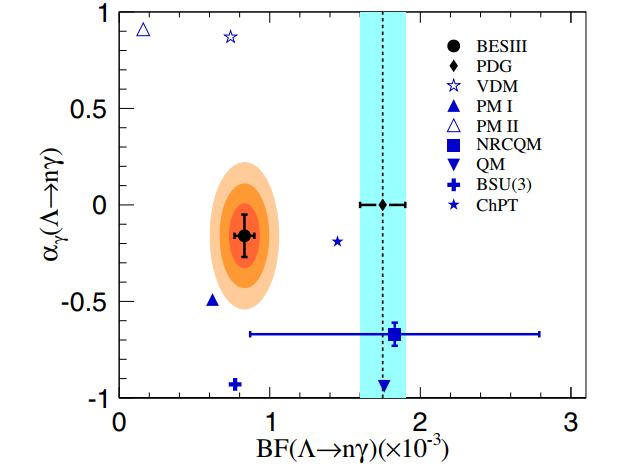The BESIII collaboration has reported the first absolute branching fraction and decay asymmetry of Λ → nγ via J/ψ→ΛΛbar process with 10 billion J/ψ data. This is the first measurement of radiative hyperon decays at an electron-positron collider experiment. The measured value of the branching fraction with improved precision, is 5.6 standard deviations different from the PDG average value. The results have been published in Physics Review Letter [Phys. Rev. Lett. 129, 212002 (2022)].
Weak radiative transitions of hadrons are governed by the interplay of the electromagnetic, weak, and strong interactions and involve parity violation (p.v.) and parity conserving (p.c.) amplitudes. According to Hara’s theorem, the p.v. amplitude of radiative hyperon decays vanishes in the limit of SU(3) flavor symmetry. It was, therefore, a surprise when several experiments reported a large non-vanishing result of the decay asymmetries. The disagreement between theoretical expectation and experimental results provoked wide interests and various solutions to the puzzle were proposed. It was suggested that the validity of Hara’s theorem could be confirmed by determining the decay asymmetry of Λ → nγ.
Making use of the huge number of polarized hyperons produced in J/ψ decays with relatively clean background, Λ → nγ is selected by utilizing a double-tag technique. The measured value of the BF is (0.832 ± 0.038stat ± 0.054syst) × 10-3 with improved precision, is a factor of two smaller, and 5.6 standard deviation from PDG average results, which are all from fix-target experiments with large flux of hyperon beams. The large transverse polarization of Λ also allows to determine the decay parameter of Λ → nγ for the first time, to be -0.16±0.10stat±0.05syst. The result of the decay asymmetry indicates that Hara’s theorem still holds for hyperon radiative decays. The results provide essential input to constrain the amplitudes of parity violation contribution in theoretical calculations, and can be used to validate the predictions and constrain the parameters of the various theoretical models.

Figure 1: Comparison of branching fraction and decay asymmetry parameters of Λ → nγ from BESIII measurement, PDG, and predictions from various theoretical models.


